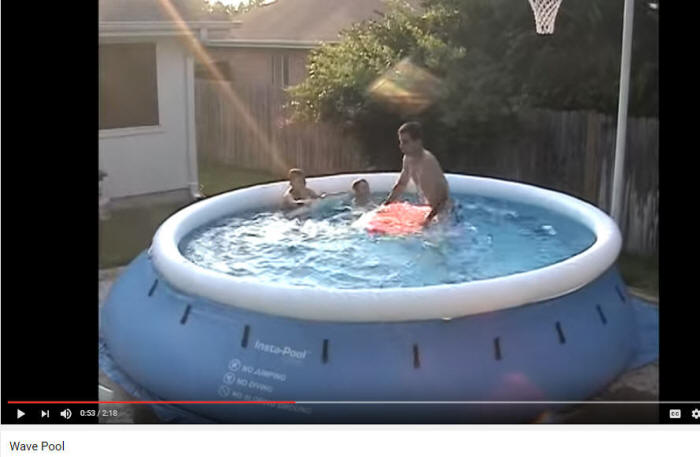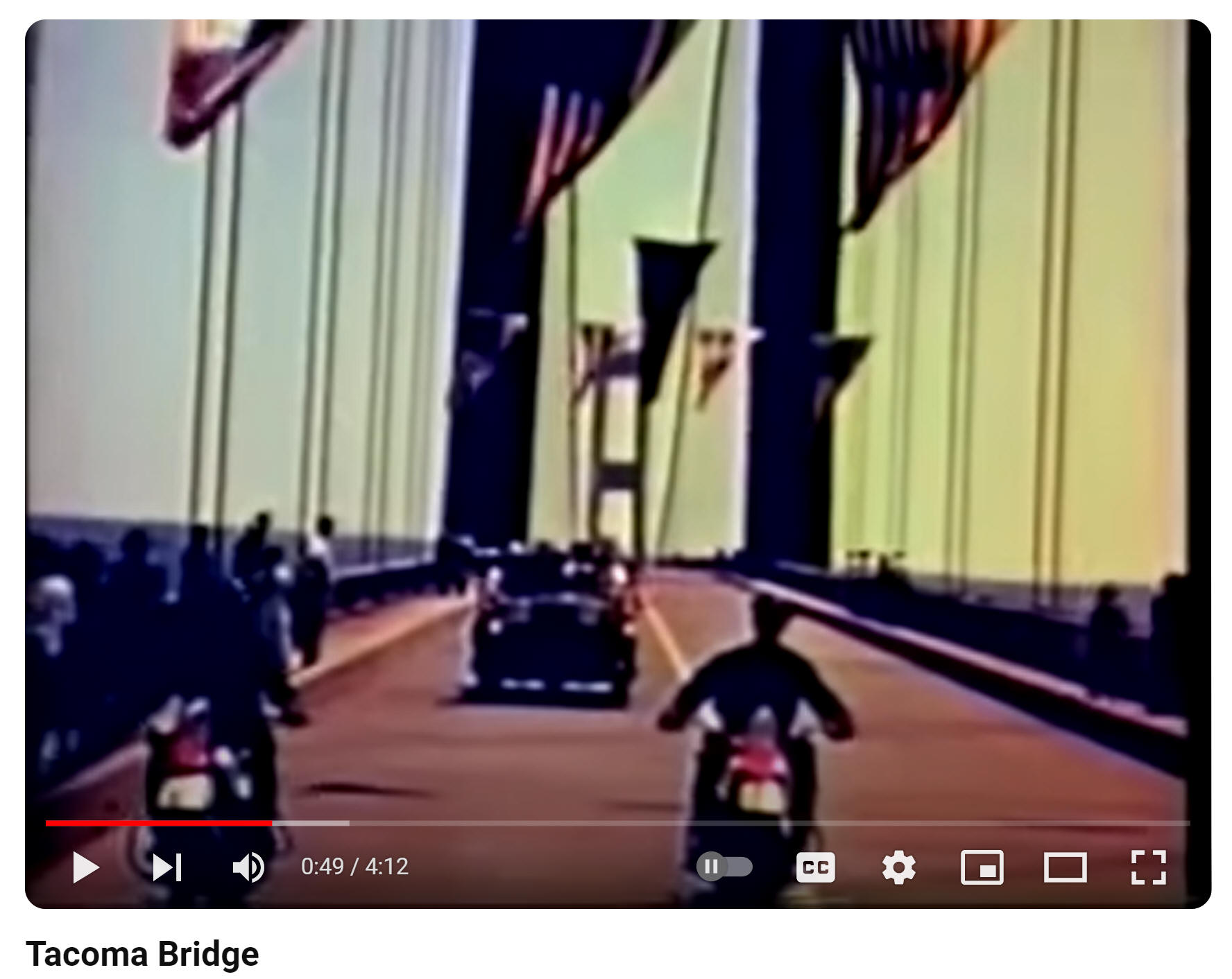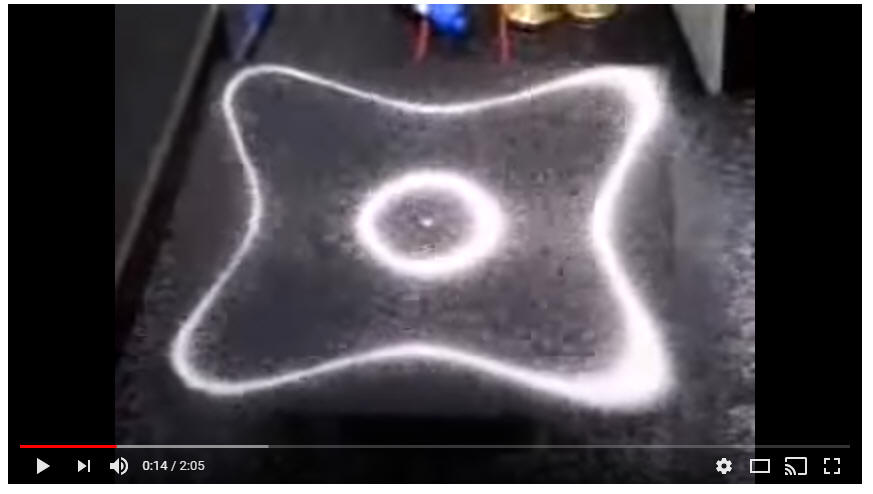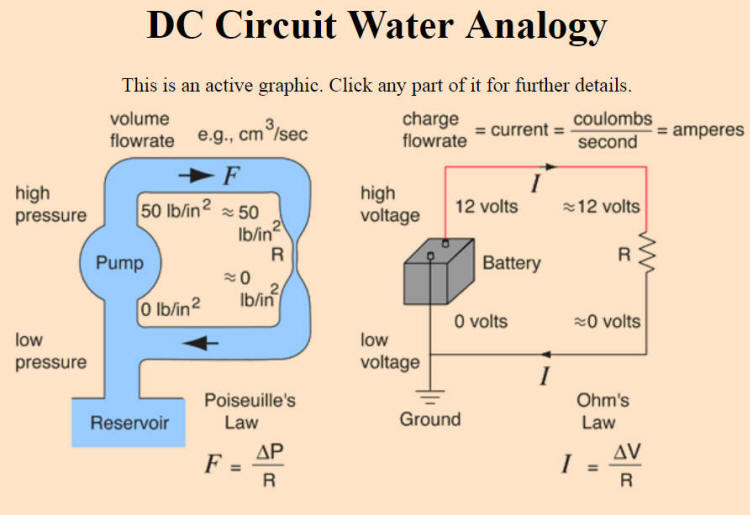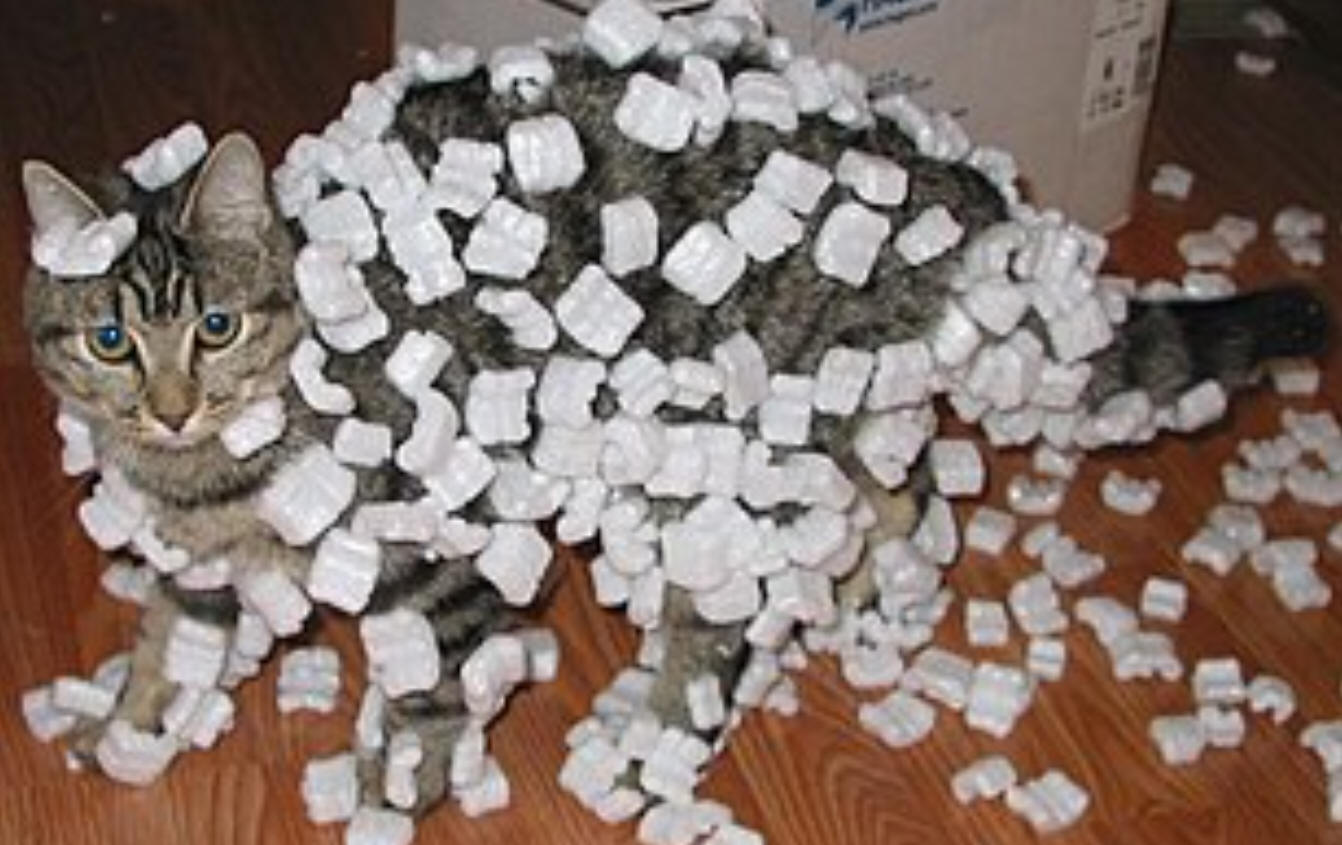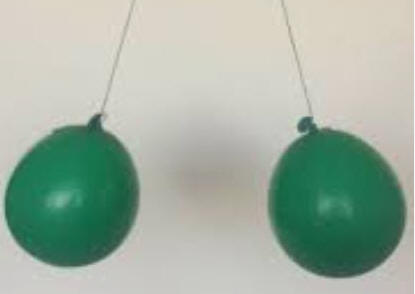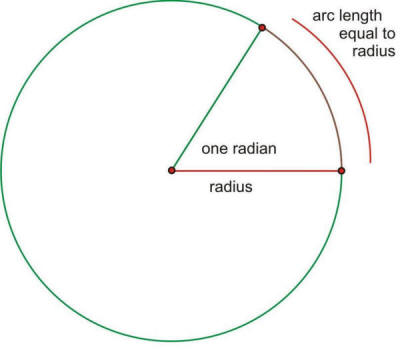Warm Up:
What waves concepts are demonstrated by the "wave pool" "volcano?"
Today:
- A7/8 -- check the homework that was due yesterday.
- A5/6 -- discuss being on time for things
- Waves quiz
- Final Exam practice problems PDF Solutions
-
Prepare for the final exam
Class 84 Wednesday, 6/5/24
Warm Up:
What waves concepts are demonstrated by the "wave pool" "volcano?"
Today:
Homework:-
Prepare for the waves quiz and final exam
Warm Up:
What evidence suggests that resonance did (or did not) cause the tacoma narrows bridge to collapse? Link 1 Link 2
Today:
- Check/review homework
- Discuss lab answers
- Ruffed Grouse and other stuff? Mechanical Waves Links
- Tomorrow: test retake (no Kirchoff) and some exam preparation stuff
-
A7/8 class only -- the rest of p. 8-9 Solutions
Warm Up:
1. What do the terms resonance and forced vibration mean?
2. Which term applies to the body of a string instrument amplifying the string's sounds?
3. Which term applies to breaking glass with sound waves?
Today:
-
The nature of the final has changed. It will be more like the
midterm.
- 10% of semester grade
-
As of now, the test has four multi-part problems/questions.
· Integrated Problem: Energy, Collisions, Rotation, and Electricity
· Rotational Motion
· Electrostatics
· Current and Circuits
- A5/6 -- check homework, then complete the final lab -- resonance in tubes
- A 7/8 -- finish notes, then the lab.
Warm Up:
1. How does violin bowing produce a constant sound? What other instrument -- without a bow -- is "energized" in the same way? (another version)
2. What are a violin's natural frequencies? What do its sound waves "look" like?
3. What does "playing harmonics" mean?
Today:
- Return tests
-
Finish notes on harmonics and overtones?
-
-
Harmonics played on a violin (video)
-
Harmonics played on a flute (video)
-
-
- A5/6 class only -- #3 and #4 on p. 8-9 Solutions
Class 82 Thursday, 5/30/24
Warm Up: None
Today:
- Test
- None
Warm Up: What is going on in this video? Why does the salt pile up in specific locations?
Today:
- B1 Class photo at beginning and end
- More Notes: harmonics and overtones in tubes
- Handout 11: Waves and Sound PDF
- None
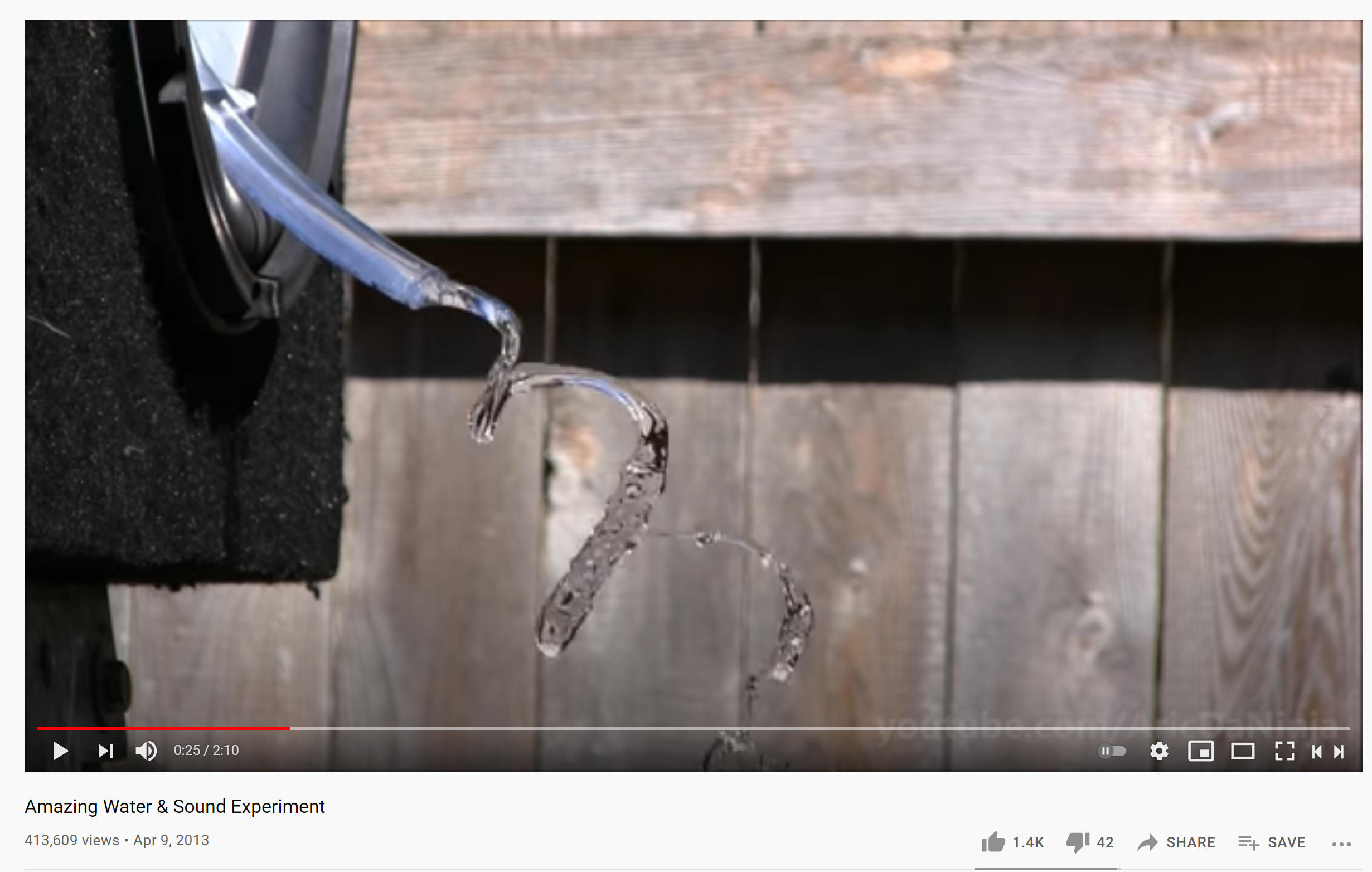 Class
81 Tuesday, 5/28/24
Class
81 Tuesday, 5/28/24
Warm Up: What's happening in the "Amazing Water and Sound Experiment?"
Today:
- Class photo at beginning and end
- Notes: Begin Handout 11: Waves and Sound PDF
- Mechanical Waves Links
- A few things:
- Rubber Band Car Project grades are finally in. Everybody got 2/3 of the points "automatically," since you built the cars (1/3) and raced the cars (1/3). The final 3rd was based on your reflections (Google Classroom assignment)
- Thursday: Circuits and Current Test -- retake next Wednesday.
- The waves unit: will be short, focusing on the basics and the most interesting parts of the normal waves unit. There will be a short quiz next Friday, with no option for a retake. If you know you won't be in class that day, you can take the quiz earlier.
- Final Exam: I will hand out an exam review guide by next Monday. For now, expect an exam over the test material from this semester. The scope will be reduced to the main ideas. Problems will be relatively straightforward. So, if you would like to start studying now, go through your old tests, starting with Energy and Work.
- P.4 (sound practice) Solutions
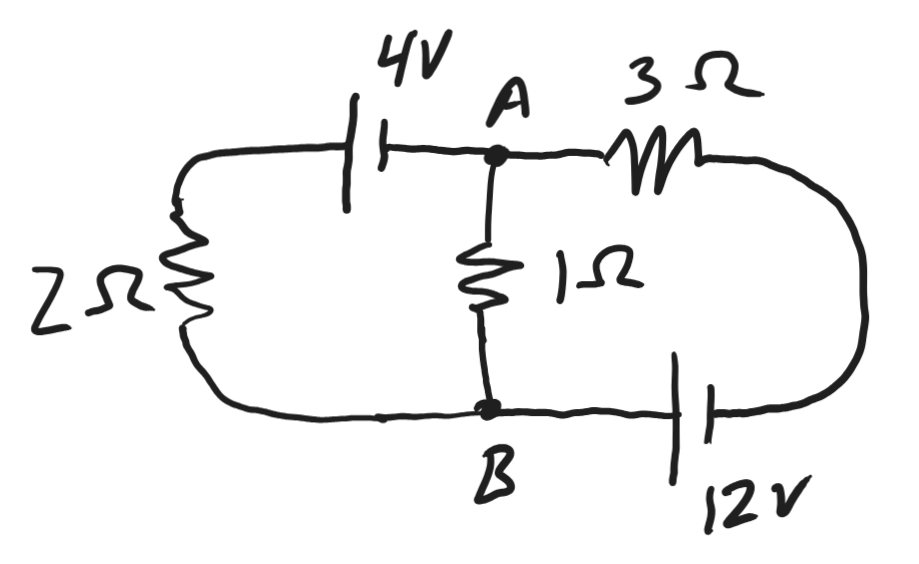 Class
80.5 Friday, 5/24/24
Class
80.5 Friday, 5/24/24
Warm Up: Find the currents in this circuit (using Kirchoff's rules)
Today:
- Class photo at beginning and end
- Check/review homework
-
Provided Test formulas:

- What's on the test PDF
- If there's time, watch the"Amazing Water and Sound Experiment?"
- None. Test next Thursday. Begin waves on Tuesday.
 Class
80 Thursday, 5/23/24
Class
80 Thursday, 5/23/24
Warm Up:
1. What happens when you electrocute a kosher dill pickle? Why?
2. What are its V, I, R, and P? When?
More nuanced explanation -- I'm becoming skeptical of this one, but I think it has some good ideas.
Today:
- Class photo at beginning and end
- Check/review homework
- Another video to share
- Discuss circuit lab answers
-
Unit 10 handout -- Current and Circuits (PDF)
Learn about Kirchoff's Rules. Use this diagram to imagine "traversing a loop" and to think about junctions...

- Test review tomorrow. Then start the final unit. Test next Thursday
- Mr. Chase Circuit Reduction Exercise Full solutions (let me know if you find any mistakes)
- Complete the next two Kirchoff's Rules problems. Solutions
Class 79.5 Wednesday, 5/22/24
Warm Up:
None
Today:
-
Finish the lab
- Circuit Lab PDF
- Multiple choice section of the practicce test (p.16-18) Solutions

 Class
79 Tuesday, 5/21/24
Class
79 Tuesday, 5/21/24
Warm Up:
Suppose you wired the 10W bulb and the 2hp table saw (see photos) on the same circuit in your house.
1. What would happen if you wired them in parallel?
2. What would happen if you wired them in series?
Today:
-
Check/review Homework
- Circuit Lab PDF
- Finish the circuit lab calculations through number 4 -- if you didn't collect enough data in class, make up reasonable numbers that work with one another.
 Class
78.5 Monday, 5/20/24
Class
78.5 Monday, 5/20/24
Warm Up:
You are tasked with building a circuit using these two incandescent bulbs, the battery, wires of negligible resistance, and no other resistors.
1. Where do you connect the wires to the bulbs?
2. What path does the charge follow as it traverses a bulb?
3. How could you wire the bulbs so that both of the bulbs light up, but the 10 ohm bulb burns brighter?
4. How could you wire the bulbs so that both of the bulbs light up, but the 1 ohm bulb burns brighter?
5. Which scenario would produce the brightest bulb? Which bulb would it be?
6. Which scenario would produce the dimmest bulb? Which bulb would it be?
7. What's unrealistic about the bulb specs?
Today:
-
Discuss Homework
- Work on the practice test problems -- hint on the last problem
- Remaining to do during this unit -- bulb lab (tomorrow) and Kirchoff's rules
- Practice test (problem only) handout p. 18-20 Solutions Problems Video
-
Provided Test formulas:

Class 78 Friday, 5/17/24
Warm Up: None
Today:
- A little bit more of the notes -- Resistivity and Electric Energy Units
- Optional Retake
- Work time
- See Google Classroom assignment -- analyzing circuits and using PhET to model your work.
Class 77.5 Thursday, 5/16/24
Warm Up: Can you anticipate what comes next in Mr. Chase's energy distribution analogy for circuits?
Today:
- Check on recent homeworks
- Wrap-up the notes (all the stuff we skipped)
- Absent Students -- check out recent videos on the class YouTube Channel.
- Retake tomorrow. There will also be a circuits-related assignment.
Class 77 Wednesday, 5/15/24
Warm Up: Another water analogy...
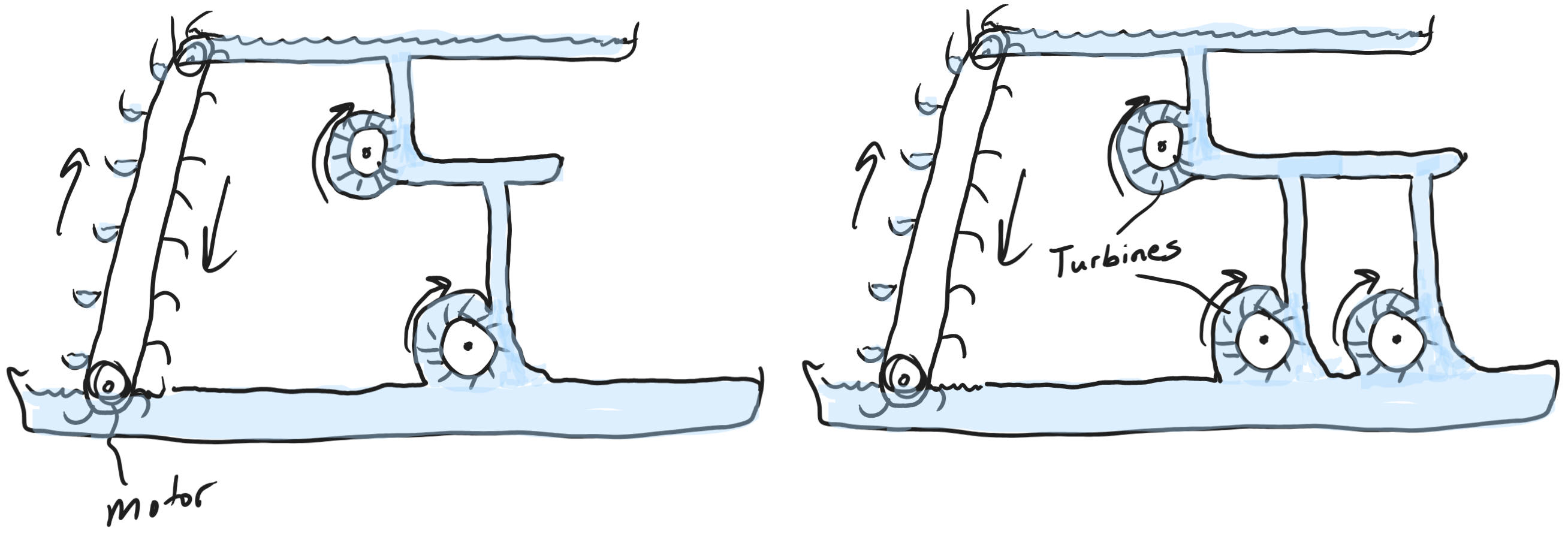
1. What part of these diagrams is like the battery in a circuit?
2. What does height represent in the diagrams?
3. What represents charge?
4. What do the water wheels represent?
5. Sketch a circuit that corresponds to each diagram.
6. For which "rules" does the analogy work well -- voltages, powers, current, resistance?
7. If the "battery" provides 5V, how much does voltage drop across each of the resistors?
Today:
- Check/review last night's homework
- More circuits practice -- Mr. Chase Circuit Reduction Exercise Solutions to p1-3
- Absent Students -- check out recent videos on the class YouTube Channel.
- Catch up on any homework that you missed due to AP exams
Class 76.5 Tuesday, 5/14/24
Warm Up: Find the missing values in these circuits.
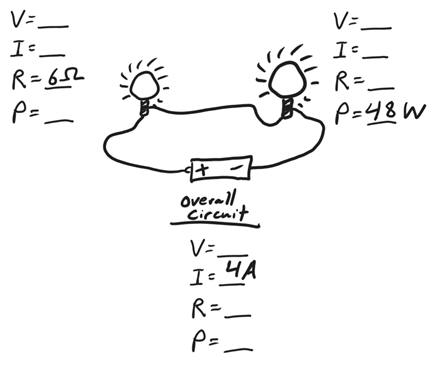
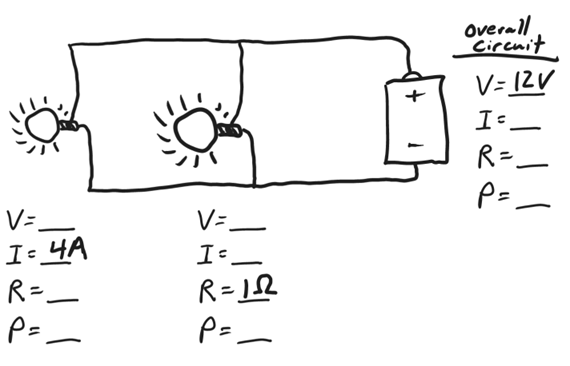
Today:
- Check/review last night's homework
- Work on ERCP #2 (see tonight's homework)
- Equivalent Resistance Challenge, Problem #2 (p. 12) Solutions to equivalent resistance challenges
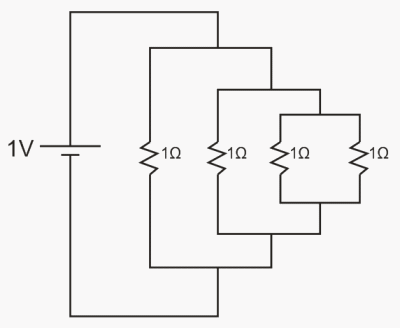 Class
76 Monday, 5/13/24
Class
76 Monday, 5/13/24
Warm Up: What is the resistance of this circuit?
Today:
- Check/review homework
-
Notes : Videos from today are on the
class YouTube playlist.
- Bits and Pieces:
- Voltage -- p. 1 (A7/8 only) 19.1 and 20.1 Solutions and Filled-in Notes
- Current -- (brief -- p.2 only) 19.1 and 20.1 Solutions and Filled-in Notes
- Ohm's law and resistance (just a bit on p.5) Packet p. 5 Filled-in notes
- Power (p.6 ) Filled-in notes
- The main notes: Resistors in parallel and series (p.7-8) Filled-in notes
- Bits and Pieces:
- Try a couple of puzzles. Make some?
- Equivalent Resistance Challenge, Problem #1 (p. 11) Solutions to equivalent resistance challenges
 Class
75.5 Friday, 5/10/24
Class
75.5 Friday, 5/10/24
Warm Up:
Let's think about current and resistance, as they relate to pressure. And also consider Ohm's Law (I = V/R)
1. What does "circuit reduction" mean?
 2.
If a car specifies "36psi (cold)" in the front tires, how much pressure
is in the front tires when they are properly inflated and cold?
How does this relate to voltage? What does V really mean?
2.
If a car specifies "36psi (cold)" in the front tires, how much pressure
is in the front tires when they are properly inflated and cold?
How does this relate to voltage? What does V really mean?
3. In the top diagram, what fraction of the total current (I), travels through point A? B? C?
4. What are the pressures at locations A-C, in the top diagram?
5. What are the pressures at locations D-J in the bottom diagram?
6. In the bottom diagram, what fraction of the total current flows through each of the resistors?
7. If the resistance of each resistor is 1
Ohm, what are the equivalent resistances of each circuit? For the
parallel circuit, use the circuit below to derive a formula.

Today:
- Return tests
- Quick lesson on calculating equivalent resistance
- 9 companions -- p. 9-10 of packet Solutions Video help
Warm Up:
Check out the active graphic
DC Circuit Water Analogy at Hyperphysics.com. According to the
analogy...
1. Voltage is like _____
2. Current is like _____
3. Resistance (R) is like _____
Today:
- Test
- Get the Unit 10 handout -- Current and Circuits (PDF)
- TBD
Warm Up:
Of which of the following statements can we be most certain?
A) The balloons have the same net charge
B) The cat and the foam "peanuts" have opposite net charges.
C) Both A and B are correct.
D) None of these answers is (are) correct.
Today:
- Check/review homework
- Questions about the test?
- Test on Thursday
- Test tomorrow
Warm Up:
What's going to happen at the moment that this Van de Graaff Generator is turned on? Why?Today:
- Check/review homework
- Finish the notes in the Unit 9, "Electrostatics Lite" handout. PDF (filled-in notes 18.4) Video from 2019
- Work time -- practice test
- Test on Thursday
 Class
73.5 Monday, 5/6/24
Class
73.5 Monday, 5/6/24
Warm Up:
Electric and Gravitational Fields -- In
the equations on the right...
1. What are the units of q?
2. What are the units of E?
4. What are the units of g? What other units would make sense?
5 How are g and E similar?
6. How are g and E different?
Today:
- Check/review homework
- Chapter 18.4 Notes (p. 8-9) -- Electric Field (filled-in notes 18.4) Video from 2019
- The rubber band car reflection assignment (in Google Classroom) is due tonight!
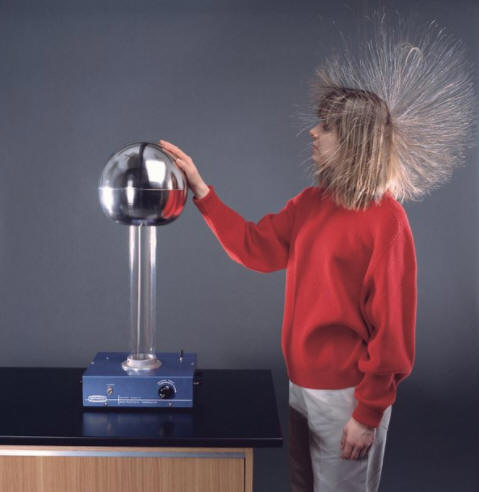 Class
73 Friday, 5/3/24
Class
73 Friday, 5/3/24
Warm Up:
1. How does a Van de Graaff Generator Work?
2. What can we do with a pith ball coated in conductive paint, suspended on a string next to the VDG?
Today:
-
Check/review homework
-
A5/6 -- charging by induction demo with the electric field detector.
-
Notes: Electric Field -- definition and drawing electric field lines (skip the math for now) -- p. 9-11 in Unit 9, "Electrostatics Lite" handout. PDF Filled-in notes 2022 Video
-
VDG demo (s)
-
Work time
-
VDG Links:
-
VDG Things to try (at some point):
-
Hair-raising
-
Pith ball
-
"Hero Engine"
- Putting out fire
homework:
- p. 11-12 #1,3, and 4 --18.5 Practice Solutions Pennington 18.5 Practice Solutions
- Phet Electric Field Hockey Simulation. Enable "field" and "trace," and try level 2 or 3. Try some positive charges and some negative charges. Try a positive puck and a negative puck. Answer this one question:
- The field lines look like paths for the puck to follow, but that's not really the case. Except with very simple arrangements of charges, the puck always starts out follwing the field lines, but then it deviates. Why doesn't the puck follow the path indicated by the field lines?
- Complete and submit the rubber band car reflection assignment (in Google Classroom) by Monday night, next week.
Class 72.5 Thursday, 5/2/24
Warm Up: How can you accidentally start a fire at a gas station?
Today:
- Check/review homework
- Notes: Coulomb's Law on p. 5-6 of Unit 9, "Electrostatics Lite" handout. PDF Filled-in Notes
homework:
- 18.3 Practice (problems 1 and 5 on packet pages 6-7) Solutions
- Complete and submit the rubber band car reflection assignment (in Google Classroom) by Monday night, next week.
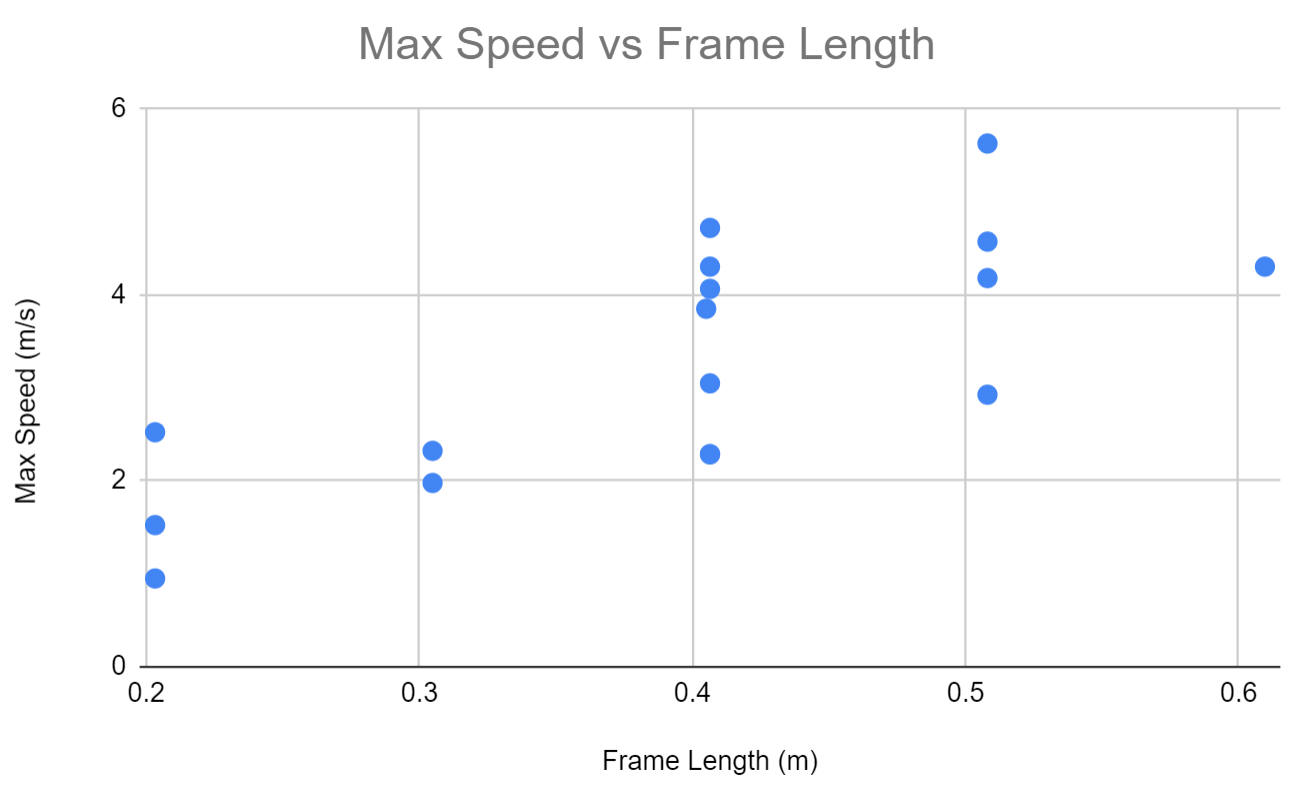
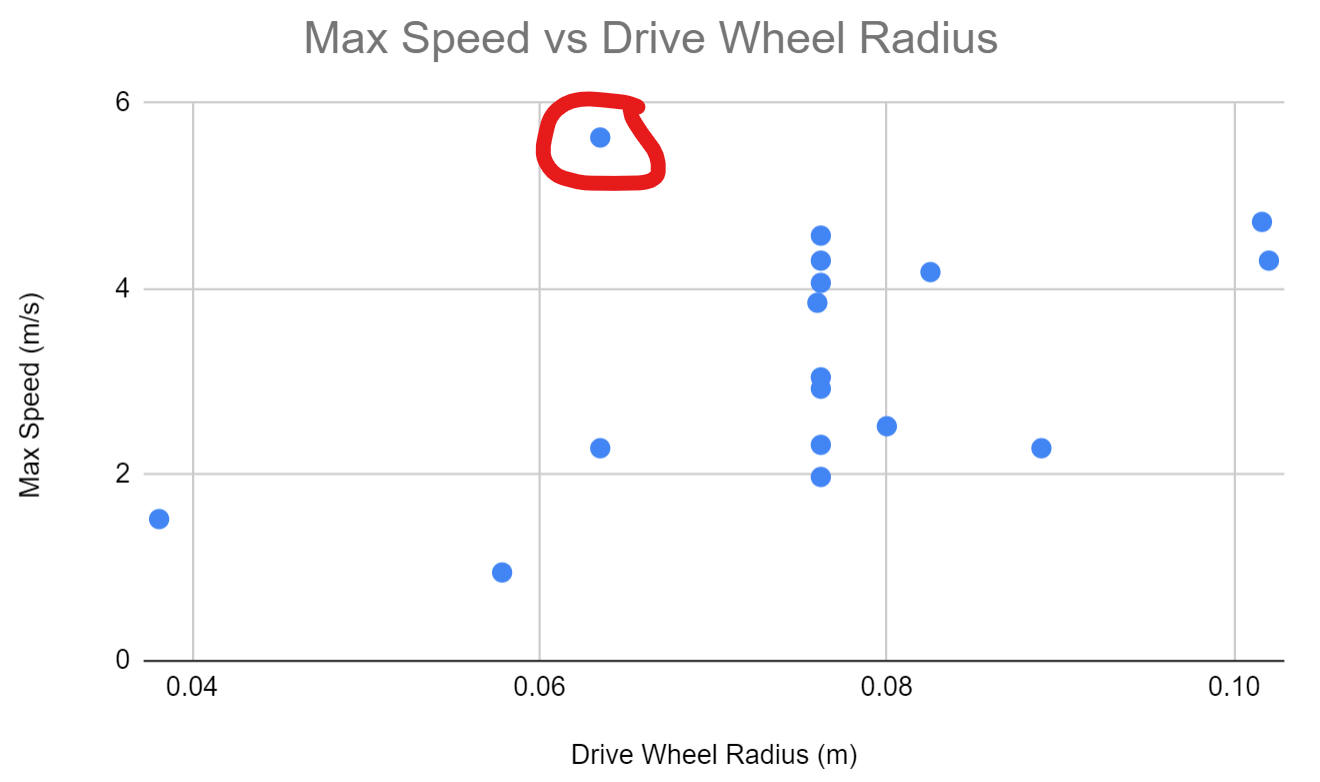
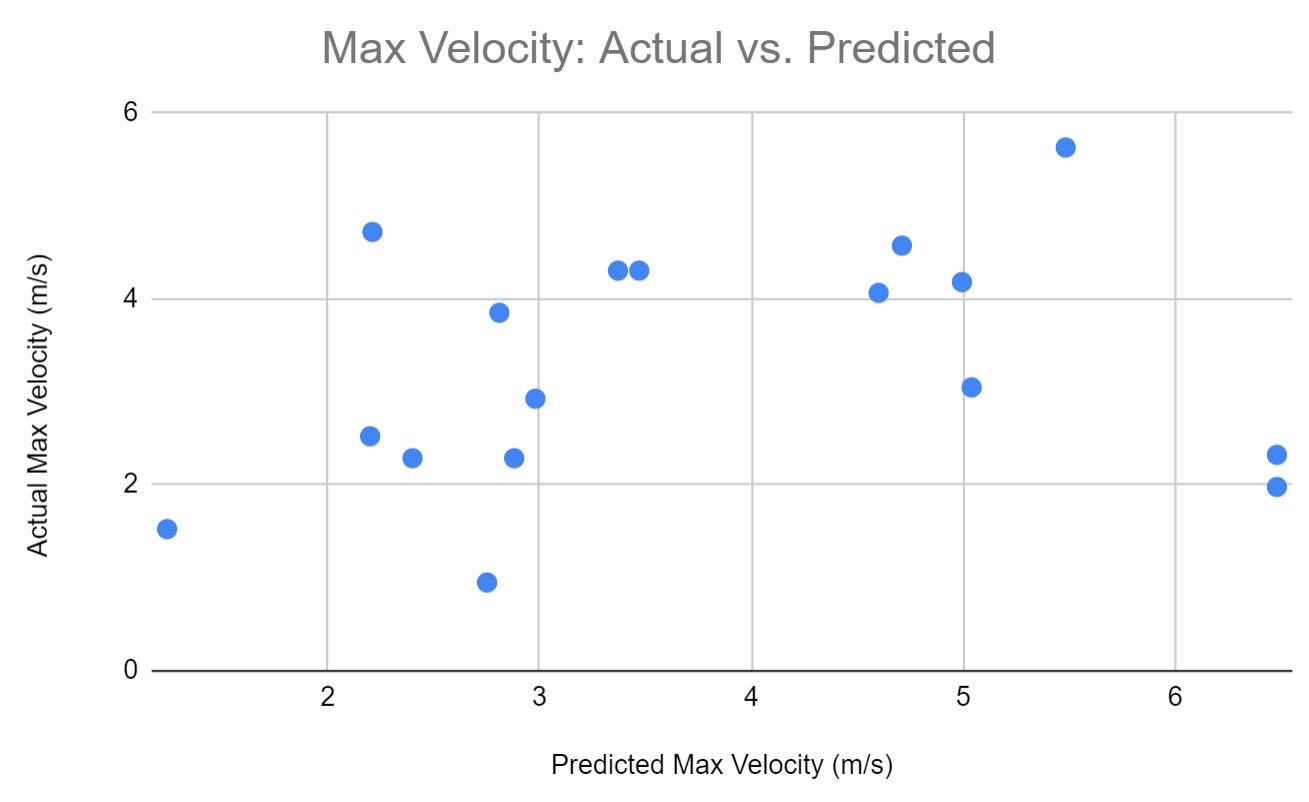 Class
72
Wednesday, 5/1/24
Class
72
Wednesday, 5/1/24
Warm Up: What do these graphs show? How did the outlier (circled in red) go so fast?
Today:
-
Car project wrap-up.
- Disassemble cars or take them home. Clean up the classroom. Return car parts in ready-to-reuse condition.
- Your project grade will be based on three components, two of
which you should have already completed. Only
the reflections will be graded strictly on correctness.
- 1) Submit a reasonable Rubber Band Car Predictions spreadsheet,
- 2) Make and "race" your car,
- 3) Complete the Rubber Band Car Reflections assignment in Google Classroom. Think of these reflections as an open-note, take-home, short answer test. You may discuss the reflections other students, but your final answers should be your own, in your own words.
- Electrostatics notes
- Get the rest of the Unit 9 Handout, continued PDF
- Continue notes where we left off. 2019 stuff: Filled-in Notes video
homework:
- Complete phet simulations #1 and #2, and answer the questions on p. 7 and 8 of the handout.
- Complete and submit the rubber band car reflection assignment (in Google Classroom) by Monday night, next week.
Class 71.5 Tuesday, 4/30/24
Warm Up:
None
Today:
Updated Measurement Procedures:
- I place blue tape on the "finish line."
- You start your car at a distance from the finish line equal to your predicted acceleration distance. I plan to lay out a tape measure.
- I will video and measure your car’s velocity at the finish line.
- The new formula will be: Score = (speed at finish)*(1- fractional error of predicted speed at finish)). Predicted acceleration distance will not be factored in to the score calculation.
- You may have repeat tries, but only during the split block, and I will delete your old video after each new try.
homework:
- None
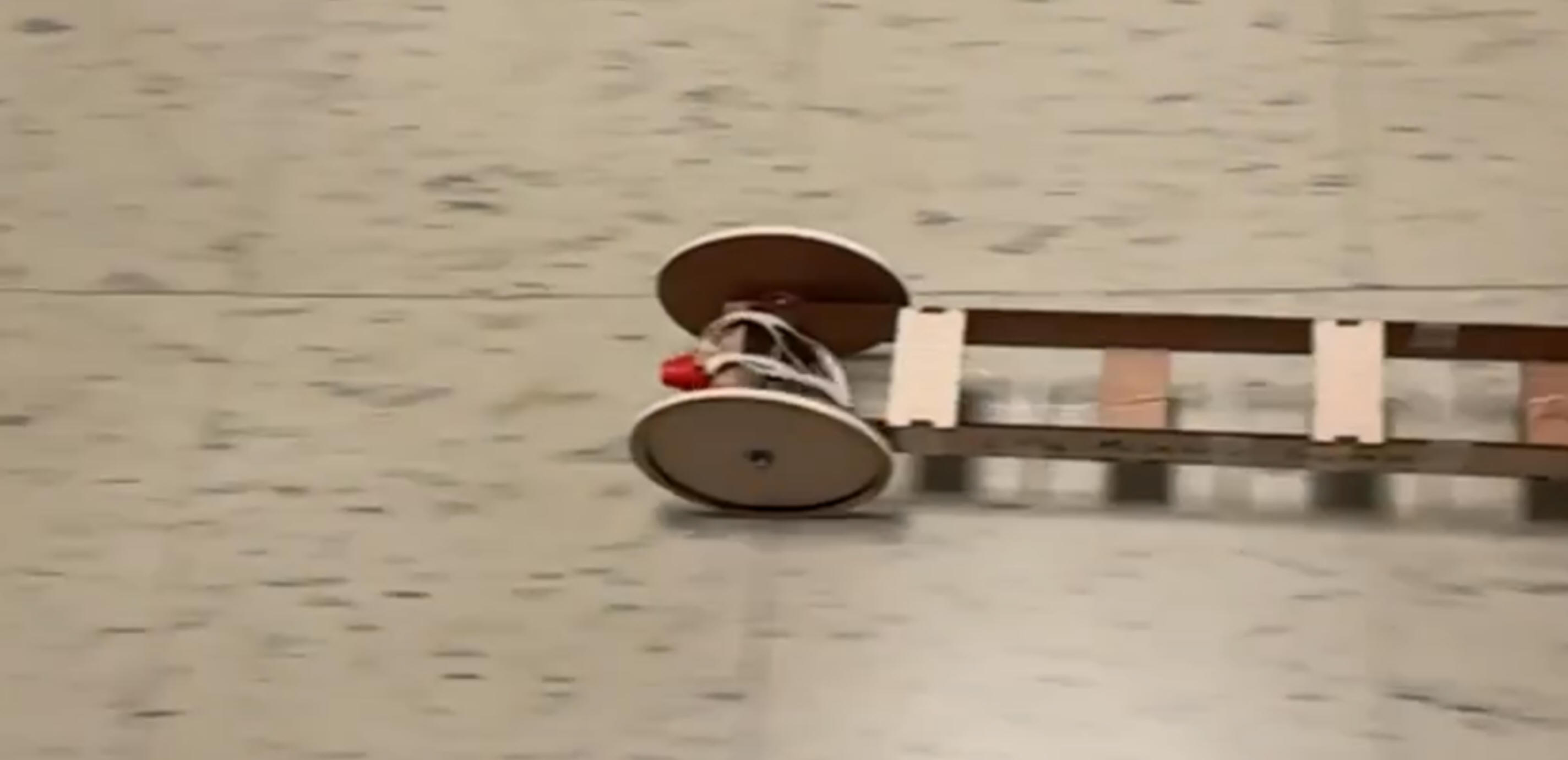 Class
71
Monday, 4/29/24
Class
71
Monday, 4/29/24
Warm Up:
How will we determine your car's maximum velocity and where your car reaches it? What are your responsibilities?
Today:
- Finish Car Predictions and begin practicing. If you're way behind, use this simplified spreadsheet.
- Submit your analysis spreadsheet today -- one per group in Google Classroom.
- Tomorrow -- the contest.
- work time
homework:
- As a group, come to class prepared for the contest measuring procedure, above. You might want to use the CoachMyVideo app for frame-by-frame analysis. That's what I use. If you find a better free app, let me know.
Class 70.5 Friday, 4/19/24
Warm Up: What steps do you have to complete before turning in your spreadsheet (and operating your car)?
Today:
- return tests
- work time
homework:
- none
Class 70 Thursday, 4/18/24
Warm Up:
None
Today:
- test retake
- work time
homework:
- none
Class 69.5 Wednesday, 4/17/24
Warm Up:
1. Why is designing/building your motor so important? How should you do it?
2. What if you have to stretch your bands to reach the drive axle?
Today:
- Optional test retake tomorrow.
- Do not operate your car until after you have submitted your predictions spreadsheet! After that, you can practice and try to match your spreadsheet predictions.
-
Assemble cars. Begin testing.
Here are some tips on...
- Wheel friction (traction) testing
- Measuring rubber band force and input energy
- Measureing rubber band output energy
- As you go, fill out a copy of this spreadsheet. It is set up to check your calculations. Here's what it looks like with example numbers in it.
homework:
- test retake tomorrow
- None -- except possibly planning what you're going to do tomorrow, so that you use your class time efficiently.
 Class
69
Tuesday, 4/16/24
Class
69
Tuesday, 4/16/24
Warm Up: After further consideration, I have decided that, on number 7 of the predictions handout, it's okay if the mass flies above the to dotted line -- as long as it doesn't hit the bar.
How does this method determine the energy provided by the rubber bands?
Today:
- Do not operate your car until after you have submitted your predictions spreadsheet! After that, you can practice and try to match your spreadsheet predictions.
-
Assemble cars. Begin testing.
Here are some tips on...
- Wheel friction (traction) testing
- Measuring rubber band force and input energy
- Measureing rubber band output energy
- As you go, fill out a copy of this spreadsheet. It is set up to check your calculations. Here's what it looks like with example numbers in it.
omework:
- None -- except possibly planning what you're going to do tomorrow, so that you use your class time efficiently.
Class 68.5 Monday, 4/15/24
Warm Up:
None -- car assembly instructions
Today:
-
Get car parts. Assemble cars -- but do not operate cars!!!
- Assembly video -- shows everything except the hubs
- You may not operate your car until after you have submitted your speed and acceleration distance predictions.
- Tomorrow -- measure your car's systems and make predictions.
- Wednesday -- practice operating your car.
- Thursday -- test retake
- Friday -- car competition
omework:
- None -- except possibly planning what you're going to do tomorrow, so that you use your class time efficiently.
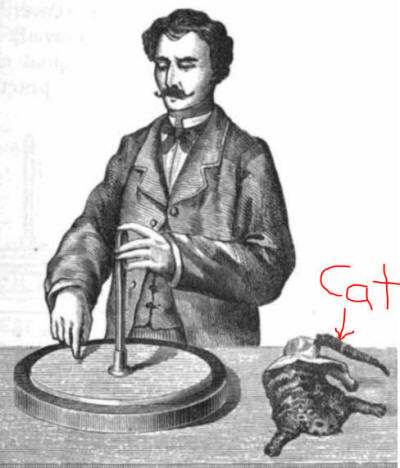
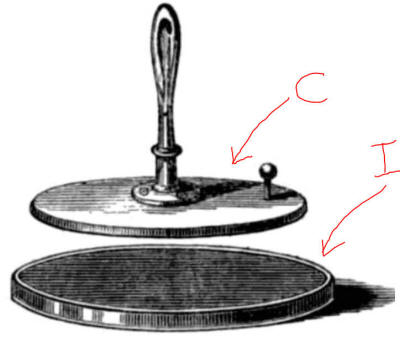
Class 68 Friday, 4/12/24
Warm Up:
The sc
ientist on the right has an insulating disk, a cat fur, and a conducting disk with an insulating handle. This apparatus can be used to create an electric shock.
1. What are conductors and insulators?
2. What are the steps involved in producing the shock?
Today:
-
Confirm car submissions
-
Finish the dip into electrostatics
-
Get p.1-4 of the Unit 9, "Electrostatics Lite" handout. PDF 2019 stuff: Filled-in Notes video
-
Notes, p. 4
-
Invisible Tape activity -- p. 2-3
-
Homework:
- None
 Class
67.5
Thursday, 4/11/24
Class
67.5
Thursday, 4/11/24
Warm Up:
1. If you rub a balloon on your head and then hold it next to your hair, your hair is attracted to the balloon. Why? Triboelectric Series
2. Your hair may also stand on end after being rubbed by a balloon. Why?
Today:
-
Check car submissions
-
Dip our toes into the electricity unit.
-
Get p.1-4 of the Unit 9, "Electrostatics Lite" handout. PDF
-
Notes, p. 1
-
Begin Invisible Tape activity -- p. 2-3
-
Homework:
- None
 Class
67
Wednesday, 4/10/24
Class
67
Wednesday, 4/10/24
Warm Up:
Can you explain how this jar lid mechanism works, in terms of Tnet=Frsinθ and F=kx?
Today:
- Check/Review the rubber band car questions
- Get a copy of the rubber band car project overview. PDF
- Overview of performance prediction process. Handout: Predicting Rubber Band Car Speed and Distance PDF
- Choose car parts Car Part Buffet (.svg)
- Fill out the request form
- The Pre-Break Plan
- Today -- submit car plan choices
- Tomorrow and Friday -- stall a little, since the new bearings haven't been ordered -- probably begin electricity.
- Monday - Assemble cars. Begin testing/analsysis
- Tuesday and Wednesday -- finish testing/anlysis
- Thursday: Test retake. Test videos are now in Google Classroom.
- Friday: Car contest. Turn-in analysis. Awards after break
Homework:
- None
 Class
66.5
Tuesday, 4/9/24
Class
66.5
Tuesday, 4/9/24
Warm Up:
1. To be stretched a distance X, a single,
ordinary rubber band (labeled A in the diagram) requires a force of 1N. How far
must the other configurations (described below) be stretched in order to
have that same tension of 1N? [Assume that the rubber bands behave
like ideal springs with a constant k.]
B. 2 rubber bands, juxtaposed
C. 2 rubber bands, linked at the end
D. 1 rubber band, cut and arranged into a
single strand
2. If you stretch each of these configurations from rest position
to a max force of 1N, which band will store the most energy?
Today:
- Get a copy of the rubber band car project overview. PDF -- fix the contest scoring formula
Homework:
- Think about your car. Next class you will create a rubber band force curve and choose your laser cut parts.
 Class
65.5
Friday, 4/5/24
Class
65.5
Friday, 4/5/24
Warm Up:
1. A ball is dropped from a height of 3 feet. At the same time, a bullet leaves a gun barrel traveling horizontally at a height of 3 feet. Also at the same time, a "frisbee" is thrown horizontally at a height of 3 feet. Which object hits the ground first?
2. How do Frisbees® work?
3. A piece of advice to new ultimate players is to "keep the fast side down." Which side of the disc is the fast side, and why might this be a helpful thing to do?
Today:
- Discuss changes to the rubber band car project overview. PDF
- Car Part Buffet (.svg)
Homework:
- Finish the rubber band car problems, if you haven't already. Rubber Band Car Problems Solutions Better Solution to #2
 Class
65
Thursday, 4/4/24
Class
65
Thursday, 4/4/24
Warm Up:
1. How can you find the North Star?
2. Why won't this work in 3,000 years?
Today:
- Begin Rubber Band Car Project (PDF) -- work on problems and mini lab (PDF) Solutions Better Solution to #2
Homework:
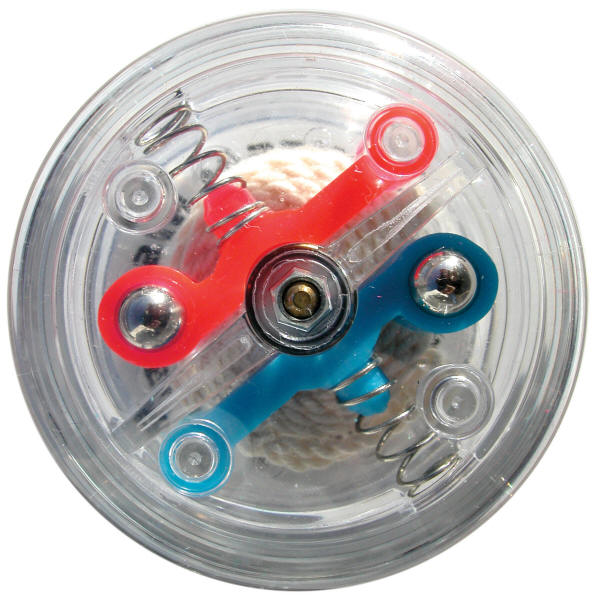 Class
64.5
Wednesday, 4/3/24
Class
64.5
Wednesday, 4/3/24
Warm Up: How does this yo-yo work? What do the springs and steel balls do?
Today:
- Return Tests
Homework:
- None
Class 64 Tuesday, 4/2/24
Warm Up: None
Today:
- Test
Homework:
- None
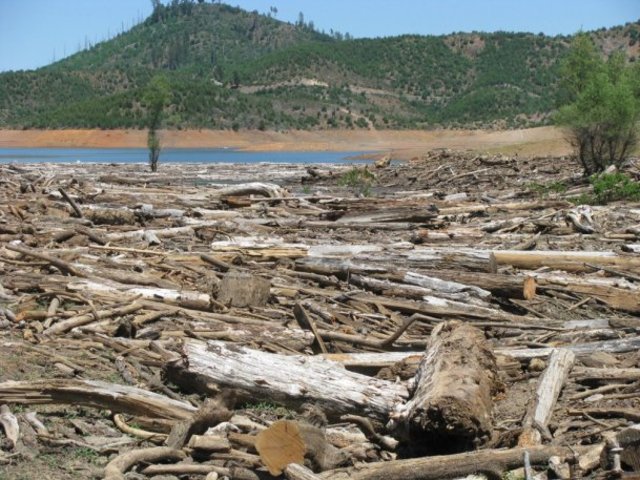 Class
63.5
Monday, 4/1/24
Class
63.5
Monday, 4/1/24
Warm Up: Suppose you need to want to build a camp fire. You have plenty of dry wood, but it's all big limbs that are too long to be manageable and too thick to break over your knee. Without using a saw or an axe, what's the best way to divide the wood into smaller pieces? Can you describe the proper technique? One solution.
Today:
- Check/review homework
- If there's time: Mr. Pennington's 4 minute drill. Answers
- Test Format:
- 10 Multiple Choice
- 5 problems
- Apply various angular kinematics formulas
- Convert between angular and linear units
- Basic torque formula
- Rotational Version of Newton's 2nd Law
- Angular Momentum
- Conservation of Angular Momentum
- Conservation of Energy with rotational and translational energy
- Torque balancing by locating a fulcrum
- Formulas offered during the test: Word Document (PDF).
Homework:
- Prepare for the test
Warm Up:
1. If you wanted to calculate the collision force between the container ship and the bridge, what data would you seek? How would you calculate force?
2. Radians can be problematic in dimensional analysis, because radians is a dimensionless unit. Explain.
Today:
- Check/review homework
- Go over the Wheel and Axle activity spreadsheet problems. I will use this version of the spreadsheet.
- Get Rotational Motion Practice Test # 2, Rotational Motion (PDF)
-
Practice Test
Solutions and Videos:
-
Solutions
(# 8 is wrong -- should be D)
to Rotational Motion Practice Test #2. If you don't understand the solutions,
watch the videos below.
- Videos:
-
Solutions
(# 8 is wrong -- should be D)
to Rotational Motion Practice Test #2. If you don't understand the solutions,
watch the videos below.
Homework:
- Complete any
of the following:
- Multiple choice section of Rotational Motion Test Review #1 (packet p. 18-21) Solutions to Pennington Test Review Problem solution video Multiple Choice Solution Video
- Multiple choice section of practice test #2 (solutions and videos above)
- PRoblems section of practice test #2 (solutions and videos above).
- Test on Tuesday -- review what you think needs the most work
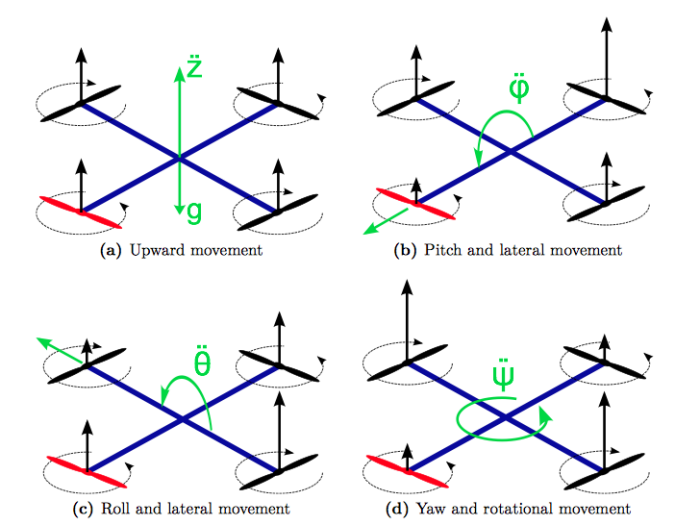 Class
62.5
Thursday 3/28/24
Class
62.5
Thursday 3/28/24
Warm Up:
A quadcopter has four propellers that usually alternate in their directions of rotation.
- How does conservation of angular momentum enable this quadcopter to achieve a yaw?
- In order to pitch or roll, why can't one motor just speed up (without the opposite motor slowing down)?
- How do regular helicopters steer and deal with angular momentum issues?
Today:
- Check/review homework
Homework:
- Complete the problem section (p.21) of Rotational Motion Test Review #1
Warm Up:
- How do falling cats always manage to land on their feet?
- How can we simulate this?
- Why wouldn't a linear version of this work? What would a linear version of this look like?
Today:
- 10.5 Angular Momentum Notes (p.15) -- Notes Key -- 2019 video part 1 2019 video part 2
- Angular momentum demos with the wheel and lazy susan.
- Do an alternate version #1 from the practice (p.16) -- What if the child were riding the merry-go-round, standing at its edge while the system rotated at 0.5rev/sec -- and then the child walked toward the center, stopping at a point 0.4m from the center. Find the system's new rotational velocity (in rev/s and rad/s).
- Discuss and clarify the scenario for the real #1 on p. 16.
Homework:
Practice Key
 Class
61.5
Tuesday 3/26/24
Class
61.5
Tuesday 3/26/24
Warm Up: The photograph on the right shows a homemade "Gauss Gun." In the picture there are 9 steel spheres and 4 cube-shaped magnets. The operator is preparing to roll one sphere toward a magnet. What will happen, and how will it work?
Today:
- Return tests
- Check homework
- Review wheel and axle lab -- do a practice problem
Homework:
- None
Class 61 Monday 3/25/24
Warm Up: None
Today:
-
Unit 8 (Rotational Motion) Handout (PDF)
- Notes: Rotational Kinetic Energy (p. 13, #1,2, and 4) Notes Key Video from 2020 -- skip forward to KE
Homework:
- Kinetic Energy Practice (p.14) Practice Key
 Class
60.5
Thursday 3/21/24
Class
60.5
Thursday 3/21/24
Warm Up:
A sphere, a cylinder, a thin hoop, and a frictionless box are released from rest at the top of ramp. Their masses and heights are identical. There is no air resistance, and everything rolls smoothly, so there is no kinetic friction.
1. Rank the objects according to their arrival times at the bottom of the ramp.
2. Suppose the bottom end of the ramp is frictionless, and when they reach the bottom, the objects hit a vertical, frictionless wall. What motions, if any, would continue after impact?
3. How would the results be different if some objects had more mass or greater size than others?
4. How would the results be different if the ramp itself were frictionless?
Today:
- Finish the spreadsheet.
- Notes?: Rotational Kinetic Energy (p. 13) Notes Key Video from 2020 -- skip forward to KE
Homework:
- Finish the spreadsheet
 Class
60
Wednesday 3/20/24
Class
60
Wednesday 3/20/24
Warm Up: Given the wheel and axle system on the right, how can we find...
1. The torque exerted by the string?
2. The moment of inertia of the wheel and axle?
3. The torque exerted by kinetic friction?
4. What assumption are we going to make that is not entirely valid (because it simplifies calculations and isn't super-impactful?
Today:
- Check/review homework
- Lab: Finding Moment of Inertia
of a Wheel and Axle
- Open this spreadsheet and make your own copy.
- Set up an apparatus like the one from the warm-up.
- Collect the data in the yellow spreadsheet cells. Follow the "helpful notes."
- Work your way down the spreadsheet. For all but the simplest calculations, I suggest deriving a formula on paper first, and entering the formula into the spreadsheet second.
- Insert formulas into the other cells so that the spreadsheet produces the calculations shown with the example data (see screenshot pasted at the bottom of the sheet).
- As you proceed, check your success by comparing columns E and F (your formulas vs my formulas).
Homework:
- Even if it is not complete, submit your spreadsheet by the end of the school day.
 Class
59.5
Tuesday 3/19/24
Class
59.5
Tuesday 3/19/24
Warm Up: Consider the wheel and axle system on the right. A string is wrapped around the axle, and a weight is tied to the string. With the system initially at rest, the weight is released and begins to fall, unwinding the string and turning the wheels and axle.
What factors determine the rate at which the wheel and axle will rotate?
Today:
- Check/review homework
- Notes: Dynamics of Rotation (p. 11). Old Notes Key Video from 2020
Homework:
- Dynamics of Rotation Practice (p.12) Practice Key
 Class
59
Monday 3/18/24
Class
59
Monday 3/18/24
Warm Up:
1. How can we find the mass of an altered meter stick using only string and a 200g weight?
2. How can we then find the mass of a bag of clay using only the meter stick and string?
Today:
- Change: Momentum/impulse retake on Monday, 3/25
- Notes:
- Angular Acceleration and Intro to Rotational Kinematics (p.7) Notes key Video from 2021-22
- Kinematics of Rotation Notes (p.9) -- Key (2019 video)
Homework:
-
Angular Acceleration Practice (p. 8) -- Key
Warm Up:
1. 360º = _____ radians
2. 90º = _____ radians
3. 2 radians = _____ degrees
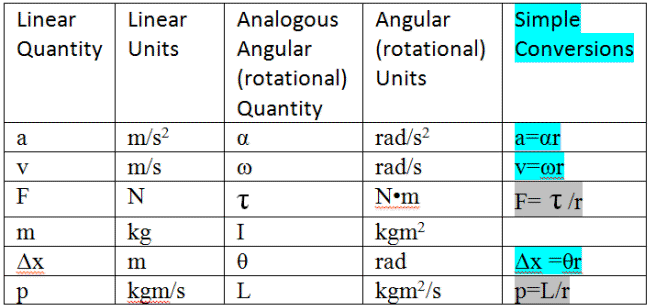 4.
Check out the units from
4.
Check out the units from
Today:
- Return Tests
- Momentum/impulse retake on Monday, 3/25
- Next class -- Notes: Angular Acceleration and Intro to Rotational Kinematics (p.7) Notes key Video from 2021-22
Homework: None
Warm Up:
NoneToday:
- Test
Homework:
- None
 Class
57.5: Wednesday,
3/13/24
Class
57.5: Wednesday,
3/13/24Warm Up:
In what general area does the fulcrum need to be placed in order to balance the beam? The beam is 8m long. It has an evenly distributed weight of 300N.Today:
- Check/review homework.
- Last minute questions about the test?
- Challenge Problem: Measure the mass of an object using a separate 200g mass, a wooden dowel, and a string, by hanging only one item from the dowel at a time. You may use a meter stick for measuring only, and you may make small marks on the dowel. You may confirm the mass of the 200g object on a balance, but the balance may not be used for any other purpose. Your answer must have 5% error or less.
Homework:
- Test tomorrow
 Class
57: Tuesday,
3/12/24
Class
57: Tuesday,
3/12/24Warm Up:
1. What is torque?
2. Describe how two people of different weights can balance on a seesaw.
3. What are the other rotational analogs of the linear quantities we have been working with all year?
Today:
- Check/review homework.
- Begin Rotational Motion
-
Unit 8 (Rotational Motion) Handout (PDF)
- Notes: Torque and balancing torques (p. 1-3) Torque Notes Key
- Some practice problems
Homework:
- Momentum test on Thursday
- Torque Practice p. 4-6 Torque Practice Solutions
Warm Up:
1. Describe each of the quantities below and explain how each relates to a collision (or any 3rd law pair of forces).
2. What can a change in one tell us about changes in others?
| impulse | change in momentum | impact force | impact time | coefficient of restitution | |
| impulse | X | ||||
| change in momentum | X | X | |||
| impact force | X | X | X | ||
| impact time | X | X | X | X | |
| coefficient of restitution | X | X | X | X | X |
Today:
- Check/review homework.
- Test on Tuesday -- here's the format:
- 3 short answer questions with
multiple parts, relating to
- momentum, impulse, impact force, impact time, coefficient of restitution
- when momentum is conserved, and when it is not
- when mechanical energy is conserved, and when it is not
- 5 problems
- Ft = change in momentum
- p = mv
- conservation of momentum
- finding velocity with a ballistic pendulum
- collision with coefficient of restitution, requiring system of equations
- 3 short answer questions with
multiple parts, relating to
- Work time
Homework:
- 2013-2014 Pennington Quiz (plus an additional coefficient of restitution problem). Your test will have some short answer questions, and the ballistic pendulum problem will not be a bonus. Answers/solutions.


 Class
55.5: Thursday,
3/7/24
Class
55.5: Thursday,
3/7/24Warm Up: The pictures on the right show a traditional water wheel followed by two Pelton Wheels. The Pelton wheels extract more energy from the water. How?
wikipedia (pelton wheel) Videos: short --Animation longer --Large Hydroelectric Dam Pelton Wheel
Today:
- Check/review homework
- As a group, finish your ballistic pendulum calclations, and submit them in Google Classroom. Check your group's work.
Homework:
- Answer the questions on page 5 of the handout. The questions ask "when?" Limit your responses to "during impact" or "during the swing." Unit 7 Packet (Unit 7 Packet -- PDF Version)
 Class
55: Wednesday,
3/6/24
Class
55: Wednesday,
3/6/24Warm Up: This Top Gear episode features a Renault Modus (compact car) vs. Volvo wagon in a head-on crash.
1. What do you expect from this video?
2. Were you right?
Today:
- Use a ballistic pendulum to measure the muzzle velocities of various Nerf launchers. Collect data and complete the spreadsheet. Ballistic Pendulum Instructions (PDF)
Homework:
Warm Up: None
Today:
- Optional test retake
Homework:
- Practice test problem 4 (ballistic pendulum), page 16. Solution
 Class
54: Thursday,
2/22/24
Class
54: Thursday,
2/22/24Warm Up: Assuming that a cart has the same constant acceleration (a) when it is rolling downhill and rolling uphill...
1. Write an equation for the cart's speed, vc, attained after being released from rest and accelerating downhill a distance dc.
2. Write an equation for the cart's initial speed, vs, with which it starts rolling uphill before accelerating to a stop after a distance ds.
3. Write an equation for the coefficient of restitution (e) for the collision that occurs after the cart accelerates a distance dc toward the collision point and just before it rebounds a distance ds away from the collision point. Assume that the car starts and ends at rest and that its acceleration is always directed toward the collision point.
Today:
-
Check/review homework
-
Solve a ballistic pendulum problem (p. 6 and 5) -- calculations first, theory second.
-
Get in groups, finish the lab questions. Then complete the short group quiz.
-
Compare lab answers. Discuss.
Homework:
- Test retake tomorrow (work/energy) -- if you think you will need more than a split block, plan to be here for both splits.
- Due tomorrow (or after break -- your choice) -- practice test problem 4 (ballistic pendulum), page 16. Solution
Warm Up:
None
Today:
- Mr. Stapleton is at the courthouse.
- Work on the homework.
Homework:
- Practice test on p. 14-16, except for problem #4 (ballistic
pendulum).
- Short Answer: some possible answers
- Problems: Solutions
 Class
53: Tuesday,
2/20/24
Class
53: Tuesday,
2/20/24Warm Up:
Suppose you start up the Newton's cradle by pulling aside and then releasing one sphere. As the cradle does its thing...
1. When is the collective momentum of the all of the spheres conserved? How can you tell?
2. When is the collective momentum of the spheres not conserved? How can you tell? Why?
3. What happens to the total mechanical energy of the spheres as they move back and forth?
4. What happens to their total kinetic energy?
5. What other type(s) of mechanical energy do the spheres have during their movements?
6. What happens when you pull aside and then release two spheres? Three? Four? Why?
7. Would it be possible to build a Newton's cradle that "kicks out" a number of spheres that is different from the number that cause the collision? If so, how?
Today:
- A5/6 follow-up to yesterday's warm-up. And did anyone calculate e for the collision that I described?
- A7/8 check/review homework
- I have a jury summons tomorrow, so you'll have a susbstitute. Spend tomorrow's class working on the homework or preparing for the work/energy test retake.
- The test retake will be on Friday. If you think you'll need more than a split block, try to arrange spending both split blocks in physics.
- Lab -- collisions with a force meter. Finish and discuss the answers.
- Work time
Homework:
- Due on Thursday:
- Practice test on p. 14-16, except for problem #4 (ballistic
pendulum).
- Short Answer: some possible answers
- Problems: Solutions
 Class
52.5: Monday,
2/19/24
Class
52.5: Monday,
2/19/24Warm Up: Suppose I place some foam on my table top, and then I shoot it with the two darts in the picture, using the same Nerf ® gun. Compare the effects of the two darts impact on the motion of the foam.
Today:Today:
- Return the tests -- after some people finish. Distribution...

- 5/6 -- check/review the homework.
- A7/8 Only -- Notes: Elastic and Inelastic collisions +
Coefficient of Restitution -- p. 3-4.
- Notes key
- Videos from 21-22 year:
- If there's time in A5/6 -- start figuring out how to find closing speed once you collect lab data.
Homework:
- A5/6 -- no homework
- A7/8 Only -- Problems 13-14 on packet p. 9.
Warm Up: None
Today:
- Test
Homework:
- A5/6 Only (A7/8 will do this later) -- Due on Monday -- Problems 13-14 on packet p. 9. Answers are at the bottom of page 10.
 Class
51.5: Thursday,
2/15/24
Class
51.5: Thursday,
2/15/24Warm Up:
The coefficient of restitution for a collision is defined as e = separation speed / closing speed
1. Write an equation for the coefficient of restitution for a ball that bounces to a height of hf when dropped from a height of hi. e = ?
2. How does e relate to efficiency?
Today:
- Check/review homework
- Unit 7 Packet (Unit 7 Packet -- PDF Version)
- A5/6 Only -- Notes: Elastic and Inelastic collisions +
Coefficient of Restitution -- p. 3-4.
- Notes key
- Videos from 21-22 year:
- Questions about tomorrow's test?
Homework:
- A5/6 Only (A7/8 will do this later) -- Due on Monday -- Problems 13-14 on packet p. 9. Answers are at the bottom of page 10.
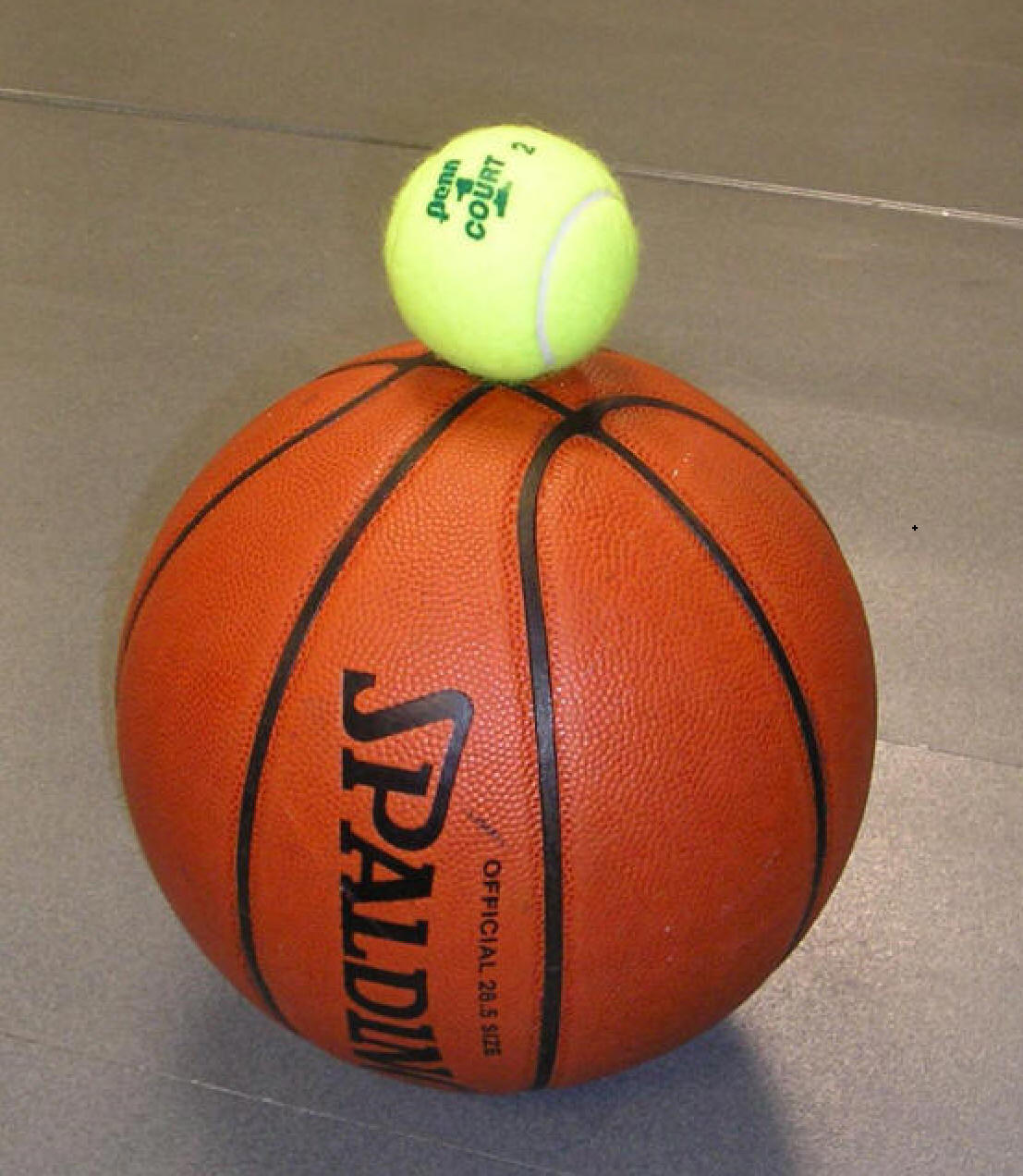 Class
51: Wednesday,
2/14/24
Class
51: Wednesday,
2/14/24Warm Up:
1. What happens when I hold a tennis ball on top of a basketball and drop them to the floor together?
2. Can you explain why this happens in terms of momentum?
3. How could you make this an even more extreme demonstration?
4. How could this concept be applied to towel snapping?
Today:
- Check/review homework
- Unit 7 Packet (Unit 7 Packet -- PDF Version)
- Notes: Momentum, Impulse, and Conservation of Momentum -- get
through #17 on p. 3.
- Notes key
- Videos from 21-22 year:
Homework:
- Optional test retake on Wednesday.
-
Problems 4-9 on packet p. 7-8.
Answers are at the bottom of page 10.
-
Homework help video for problems 7-10
 Class
50.5: Tuesday,
2/13/24
Class
50.5: Tuesday,
2/13/24Warm Up:
When the two blocks collide, they stick together. What is the shared velocity of the two blocks after the collision?Today:
- Unit 7 Packet (Unit 7 Packet -- PDF Version)
- Notes: Momentum, Impulse, and Conservation of Momentum
- Notes key
- Videos from 21-22:
Homework:
-
Problems 1-3 on packet p. 7-8.
Answers are at the bottom of page 10.
-
Homework help video for problems 7-10
 Class
50: Monday,
2/12/24
Class
50: Monday,
2/12/24Warm Up:
1. How does a hydraulic lift facilitate work with a small input force and a large output force? In general, how do hydraulics produce so much force?2. How could you lift a room full of people by blowing air through a straw?
Today:
- More test review
- The big picture -- what happens to energy
- The list of tools
- Practice:
- Energy video situations revisited. Here's
the handout --
PDF.
For each scenario, I wrote an equation and a verbal
description. You should be able to do the same.
You should also be able to generate an equation based on the
description, and vice-versa. I did not double-check my
answers; please let me know if you discover mistakes.
- Write the simplest possible equations representing what is happening in each numbered situation. Here are my equations. The thing that makes them the simplest is that quantities that change are assumed to be zero on one side of the equation.
- Write verbal descriptions for each of these scenarios. I kept mine generic (e.g. "a mass m is lowered a height h while a spring with constant k is compressed a distance x.). These could form the basis for test problems -- all you would have to do is replace the variables with numbers (except for the varible that the solver of the problem is trying to find). Here are my verbal descriptions. They are not necessarily the only acceptable descriptions.
- Extra Test Review questions and problems. (PDF) Solutions -- let me know if you think you see mistakes. If you can do all of these, correctly, on your own, without looking anything up, you are probably all set to take the test. If you can't do them on your own, you still may be okay on the test. They're a little harder than the test.
- Energy video situations revisited. Here's
the handout --
PDF.
For each scenario, I wrote an equation and a verbal
description. You should be able to do the same.
You should also be able to generate an equation based on the
description, and vice-versa. I did not double-check my
answers; please let me know if you discover mistakes.
Homework:
- Test on Friday. We will start the momentum unit tomorrow.
